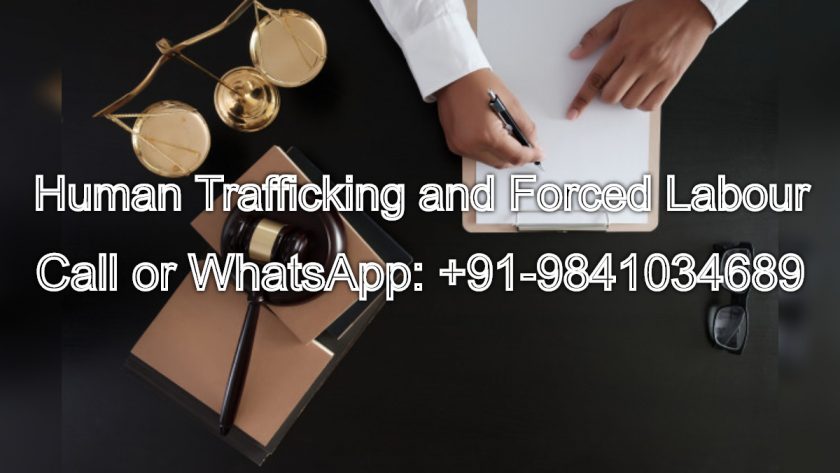Human trafficking is an illicit trade for the purposes of forced labor, sexual servitude or commercial sexual exploitation of people or others may include the provision of the pair in the context of forced marriages, or the extraction of organs or tissues, including the elimination of surrogacy and ovum.
What is Human Trafficking and Forced Labour?

Violation of the victims’ rights
Human trafficking can basically occur within a country or trans-national. Human trafficking violates victims’ rights through coercion and commercial exploitation. Typically, it affects vulnerable individuals, such as women and children. Additionally, trafficking does not always involve moving people between locations. Therefore, addressing this crime requires focusing on the exploitation itself, not just movement.
United Nations
Palermo protocol
Although human trafficking can be local or domestic, it has implications internationally. The United Nations Protocol to Prevent, Suppress and Punish Trafficking in Persons recognizes this crime. Specifically, it addresses trafficking of women and children. Additionally, the Palermo Protocol is an international treaty under the UN Convention. This treaty entered into force on 25 December 2003. Interpol plays the main role in the eradication.
Trafficking Protocol
The Trafficking Protocol is a global, legally binding instrument on human trafficking. It is the first in over fifty years with an agreed definition. One aim is to facilitate international cooperation in investigating traffickers. Additionally, it seeks to assist and protect victims of human trafficking. Importantly, it upholds their rights as per the Universal Declaration of Human Rights. Trafficking Protocol, which has 117 signatories and 173 parties per November 2018, which defines Human trafficking as follows:
Human trafficking by means of threat
(A) Recruitment, transportation, and transfer of persons involve threats, force, or coercion. Additionally, abduction, fraud, and deception are common methods used. Abuse of power or exploiting vulnerability may also occur. Offering payments or benefits to gain control for exploitation is another tactic.
Prostitution
Exploitation in the protocol includes prostitution or other forms of sexual exploitation. Additionally, forced labor, slavery, and servitude are covered. It also encompasses manipulation or organ removal.
(B) The consent of a victim of trafficking to the exploitation set forth in sub-paragraph (a) of this article is irrelevant where any of the means set forth in sub-paragraph (a) have been used;
(C) Any person involved in the recruitment, transportation, transfer, harboring or receipt of a child for the purpose of exploitation shall be considered “trafficking in persons” even if this does not involve any of the means of exploitation set forth in sub-paragraph (a) of this article;
(D) “A Child” in the protocol means any person under the age of eighteen.
International Labour Organization
Although forced labor is universally condemned, the ILO estimates indicate that 24.9 million people around the world still experience it. Of the total number of victims of forced labor, 20.8 million (83 percent) are exploited in the private economy, by individuals or companies, and the remaining 4.1 million (17 percent) is in the form of State-imposed forced labor.
Victims of forced sexual exploitation
Among them are exploited by individuals or companies, 8 million (29 percent) are victims of forced sexual exploitation, and 12 million (64 percent) of forced labor exploitation. forced labor in the private economy generates about the US $ 150 billion in illegal profits each year: two-thirds of the estimated amount (or the US $ 99 billion) came from commercial sexual exploitation, while the US another $ 51 billion is the result of economic exploitation force in Domestic Labour, agriculture and other economic activities
Forced Labor Convention, 1930
This convention prohibits all forms of forced or compulsory labor. The meaning of Forced labour is nothing but “any type of work or service which is forced to a person under threat to punishment. Moreover, it is which the person has not offered himself voluntarily to do.”

Exceptions apply to compulsory military service and civil liability from court convictions. In such cases, work must be supervised by a public authority. Additionally, emergency situations are exempt from this rule. Minor communal services also fall under exceptions. Importantly, individuals must not be hired by private entities.
The Convention also requires that the illegal extraction of forced or compulsory labor punishable as a Criminal offense, and that ratifying states ensure that the relevant penalties imposed by law are adequate and strictly.
Abolition of Forced Labor Convention, 1957
This fundamental convention prohibits forced labor used for coercion or education. It also bans using forced labor as punishment for political views. Additionally, it forbids using labor for economic development purposes. Forced labor cannot be used for labor discipline or punishment for strikes. Lastly, it prohibits using forced labor for racial, social, national, or religious discrimination.
Protocol 2014 to the Forced Labor Convention, 1930, and Labor (Additional Measures) Recommendation 2014
The new legally binding Protocol on Forced Labor is supported by Recommendation No. 203. This Protocol aims to advance preventive measures and enhance protection. Additionally, it seeks to provide compensation for victims. Efforts will increase to eliminate all forms of forced labor. It also targets the eradication of human trafficking.
Indian Constitution
ARTICLE 23: PROHIBITION OF HUMAN TRAFFICKING AND FORCED LABOR
(1) Traffic in humans and other forms of forced labor are prohibited and any contrary provisions of this being a violation penalty in accordance with the law.
(2) Nothing in this article that prevents the State from imposing compulsory service for public purposes, and in a state to impose such services would not make discrimination on the ground only of race, religion, caste or class .
ARTICLE 24: PROHIBITION OF CHILD LABOR IN FACTORIES, ETC.
No children under the age of fourteen years shall be used to work in any factory or mine or engaged in other hazardous occupations.
Punishments for Human Trafficking and Forced Labour
Section 370 of criminal law (amendment act 2013) – Trafficking in Persons.
Provisions Against Human Trafficking
Human trafficking for exploitation involves recruiting, transporting, harboring, transferring, or receiving individuals. First, traffickers use threats, force, or coercion to control their victims. Secondly, they might resort to kidnapping or deception to achieve their goals. Additionally, traffickers may exploit their power or offer benefits to persuade victims. Importantly, the victim’s consent is irrelevant in determining these violations. Consequently, legal action focuses on the methods used rather than the victim’s agreement.
Penalties for Human Trafficking Offenses
Involvement of Officials: An official or police officer involved in human trafficking faces life imprisonment and a fine.
General Punishment: Individuals engaging in human trafficking face rigorous imprisonment ranging from seven to ten years, along with a fine.
Trafficking Multiple Persons: Offenders involved in trafficking more than one person can receive imprisonment from ten years to life, along with a fine.
Trafficking Minors: For trafficking a minor, the punishment is rigorous imprisonment for ten years to life and a fine. Involving more than one minor results in imprisonment from fourteen years to life, along with a fine.
Repeat Offenses: Convictions for repeatedly trafficking minors result in life imprisonment and a fine.
Section 370 A of criminal law (amendment act 2013) – exploitation of the trafficked person.
(1) Anyone who knows or suspects that someone has traded a minor for sexual exploitation will face serious repercussions.Consequently, the legal system will impose stringent penalties to address this offense. Specifically, such an individual shall be punished with imprisonment ranging from five to seven years. Furthermore, they will also be liable for a fine.

- Anyone who intentionally engages in trafficking for sexual exploitation will face severe consequences. Additionally, those who believe someone has been trafficked will also face serious repercussions. Consequently, they will be subject to rigorous imprisonment and substantial fines. For instance, such an individual shall be punished with imprisonment ranging from three to five years. Additionally, the person will also be liable for a fine.
The Bonded Labor System (Abolition) Act of 1976
The Bonded Labor System (Abolition) Act of 1976 makes illegal all forms of bonded labor. Anyone who forces others into bonded labor will face legal consequences. Specifically, they shall receive a prison term that may extend up to three years. Additionally, they will be subject to fines, potentially amounting to two thousand rupees.





